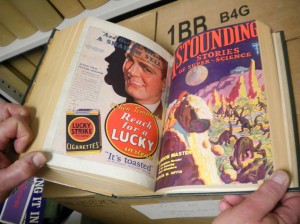 The first publication of L Ron Hubbard’s Dianetics was in the pulp magazine “Astounding Science”. In December 1949 the magazine’s editor, John W Campbell, started a campaign to promote what he believed to be a revolutionary ‘new science of the mind’.
The first publication of L Ron Hubbard’s Dianetics was in the pulp magazine “Astounding Science”. In December 1949 the magazine’s editor, John W Campbell, started a campaign to promote what he believed to be a revolutionary ‘new science of the mind’.
This post includes five issues of “Astounding”(from December 1949 to April 1950 inclusive). It describes every reference to Dianetics during that period, and provides images of the more important ones. You can also download each issue in its entirety.
I hope that I have caught every reference. However, if you come across anything I have missed, please tell me about it via the feedback page, or by leaving a comment.
December 1949
The very first reference to Dianetics in “Astounding Science Fiction” appeared in the December 1949 issue on page 80. It is reproduced below.
Dianetics was discussed in the last paragraph of an regular feature entitled “In Times to Come”(below). Here, the editor, John W Campbell Jr, briefly described the stories and articles he had planned for future issues of “Astounding” – it was a ‘trailer’ for ‘coming attractions’.
An insight into Campbell’s state of mind about this time is provided by an interview with the science fiction author Alfred Bester who met with Campbell to discuss a story. Campbell was wildly enthusiastic about “Dianetics”, and seemed to believe that Hubbard’s work deserved a Nobel Peace Prize – at least. He insisted that Bester read the proofs for the serial version that he was preparing to publish in “Astounding”. Bester’s admiration for Campbell’s intellect and judgement rapidly evaporated as he innocently read the incoherent text of “Book One.”
Campbell had evidently fallen for Hubbard’s wild claims regarding Dianetics hook, line and sinker. He promised readers a cure for “[…] ulcers, asthma and arthritis” and signed the article “The Editor”, putting the full authority of “Astounding” behind Dianetics (and it has considerable authority, among SF fans). In 1949, when medical science was far less advanced and even asthma could kill. This was surely irresponsible.
Campbell should have known better. Between 1945 and 1948 a science fiction magazine editor, Raymond A Palmer had blurred the line between fantasy and fact when he published a series of ‘articles’ by Richard Sharpe Shaver in “Amazing Stories”. These concerned a mysterious underground race who (supposedly) exert a malign telepathic influence upon mankind. As stories, they were unremarkable. When presented as fact they led to a popular fad which became known as “The Shaver Mystery“.
A Hubbard short story “A Can of Vacuum” appears immediately after this article (on page 81). During the run-up to the publication of Dianetics Campbell regularly published stories by Hubbard, and it is possible that he was persuaded to do so to:
- Provide an income for Hubbard while he ‘researched’ Dianetics
- Raise Hubbard’s profile, to insure that the coming articles about Dianetics would be taken seriously.
On page 119 we find an  advertisement for a small mail-order business selling copies of science-fiction books ( a relatively rare commodity in 1949). Only a few of the authors who appear in this list are remembered today, and then mostly by historians of SF (who judge Hubbard quite harshly)
advertisement for a small mail-order business selling copies of science-fiction books ( a relatively rare commodity in 1949). Only a few of the authors who appear in this list are remembered today, and then mostly by historians of SF (who judge Hubbard quite harshly)
Only three books by L Ron Hubbard appear in this list, which featured around 100 books at a time when advertisers were probably well aware that he was about to receive a blaze of publicity. Another mail-order bookseller with a smaller list (on page 159) carries no books by Hubbard.
Also in this issue (starting on page 54) is the conclusion of a serial by Robert A Heinlein, who had been a close associate of Hubbard. The characters in this story include a group of intellectual ‘super-humans’ who save the world. They call themselves Homo Novis (New Man). In later stories, Heinlein expressed serious doubts about this concept. Hubbard, however, later adopted the term to describe Scientologists (except that he misspelled it Homo Novus) .
For the next few months an ‘inner circle’ of Dianetics enthusiasts developed the material that would soon be released as a book and in serial form in “Astounding”.
Members included:
- L Ron Hubbard
- John W Campbell
- Joseph Winter (a doctor who wrote an introduction to Dianetics which lent some credibility to the text)
- Art Ceppos (a publisher of academic books who, in a rush of enthusiasm, offered to print “Dianetics”.
We will meet these people again, later in this series.
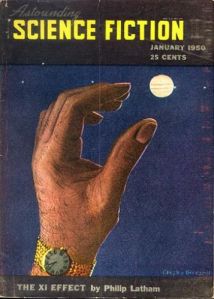 January 1950| Download Issue as .pdf | February 1950 | Download Issue as .pdf
January 1950| Download Issue as .pdf | February 1950 | Download Issue as .pdf
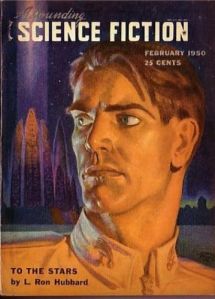 As the inner circle ‘researched’ Dianetics, and prepared it for publication, Campbell continued to regularly print stories by L Ron Hubbard.
As the inner circle ‘researched’ Dianetics, and prepared it for publication, Campbell continued to regularly print stories by L Ron Hubbard.
“Ole Mother Methuselah” appeared under the pseudonym ‘Rene Lafayette’ in the January 1950 issue of “Astounding” (left) on page 80.
Hubbard is also referred to by Campbell in this issue in a reply to a congratulatory readers letter (pg 157). He asks (semi-seriously):
What do you expect when all the top authors are Navy of ex-Navy men? Heinlein – Hubbard -the late Jameson – all helped establish the tradition!
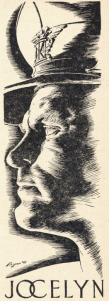 Campbell was evidently unaware of Hubbard’s less-than-impressive war record.
Campbell was evidently unaware of Hubbard’s less-than-impressive war record.
The cover of the February 1950 issue of “Astounding”(right) featured the first of a two-part story by Hubbard entitled, “To the Stars” (pg 5).
You can read this, and judge for yourself if Hubbard deserved the prestigious cover, or if Campbell was building up Hubbard’s reputation in advance of the big reveal. Certainly, Hubbard’s fiction is not celebrated by historians of science fiction.
As an aside, Page 13 of “Astounding carries an illustration of the courageous (and ruthless) starship Captain who features in the story. The modern reader has to wonder – was this how Hubbard imagined himself when he founded the Sea Org, dressed in a pseudo-Naval uniform (complete with peaked cap) and adopted the ‘rank’ of Commodore?
March 1950
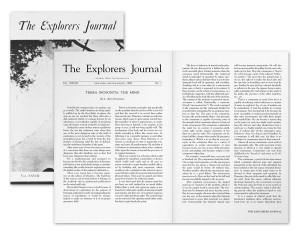
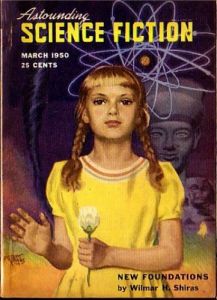 The March 1950 issue has featured before in this blog.
The March 1950 issue has featured before in this blog.
It featured an editorial about the promised revelation of Dianetics which seems to be an attempt to keep the pot boiling while the text was finalised (below).
An article by Hubbard also appeared at roughly the same time in the Winter-spring issue of the “Explorer’s Journal” (right). This was was the official publication of the Explorer’s Club, of which Hubbard was a member.
The article consisted of a sort of prototype version of Dianetics. The invented terminology used in Dianetics has not been finalised (the term ‘comanome’, used throughout, was later replaced with ‘Engram’.
The ‘Explorer’s Journal’ article suffered from the fact that Hubbard had to contort his material (which he wanted to present as ‘a new science of the mind’) into something of interest to expedition leaders. It seems to have sank without trace. It can be read in full in this previous post.
Meanwhile, in the pages of “Astounding”, the promotion of Dianetics was building up steam
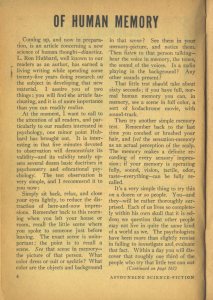
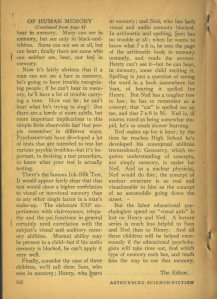 Click on the images to enlarge, or Download as .pdf
Click on the images to enlarge, or Download as .pdf
In this article, Campbell promises that:
Coming up, and now in preparation, is an article concerning a new science of human thought – dianetics. L Ron Hubbard, well known to our readers as an author, has earned a living writing while spending some twenty-five years doing research […].
I assure of two things: you will find this article fascinating, and it is of more importance than you can readily realise.
The bulk of the article is devoted to a rather puzzling mental exercise which veers off into a discussion of ESP (another of Campbell’s fringe interests). Campbell presents the rather banal insight that different people remember things in different ways as if it were a major discovery.
April 1950
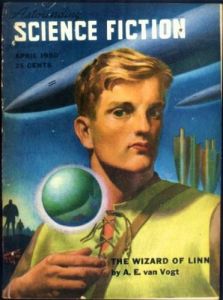 In this issue “Greed” – yet another story by L Ron Hubbard appears (pg 53). The editors introduction (a minor art form) reads:
In this issue “Greed” – yet another story by L Ron Hubbard appears (pg 53). The editors introduction (a minor art form) reads:
Piracy is a remarkable thing. It’s usually based on greed – but in highly peculiar way. Many times it’s greed for adventure, for high and dangerous living, rather than greed for wealth!
In the first few pages, Hubbard display an arrogant and literal racism:
Earth had, as we all know, several human races. But her most energetic were the yellow and the white. And the white ruled and the yellow endured. A country which had been called Russia had almost triumphed once. And then it had failed. Although ostensibly white, it was actually oriental.
I’m not sure what Vladimir Putin would make of this.
In my next post, we move on to the serialisation of Dianetics, beginning with the iconic May 1950 issue.
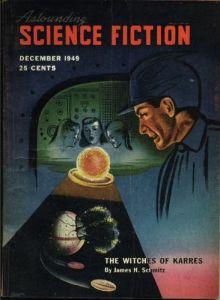
This passage is not only racist, but nonsenscial. Europeans or white people, also known as Caucasians, are named after the Caucasus mountains, which are located – guess where? – in Russia. Russians are by definition more “white” than Hubbard was. But, of course, he was writing during the Cold War, so dehumanizing the Russian people was required at that time.
One of the problems I had with examining Hubbards’ articles in “Astounding” was that there were layers of nonsense – misconceptions within mistakes wrapped up in fabrications. It’s impossible and pointless to try to get to the bottom of it – you just try and point out the significant nonsense.
However, having said that, I overlooked that point. Well spotted!
Pingback: Can Scientology Cure Asthma? | Penumbral Jots